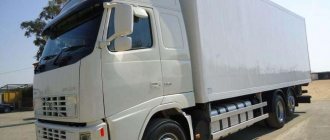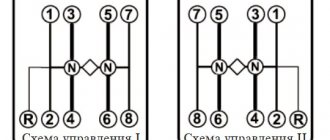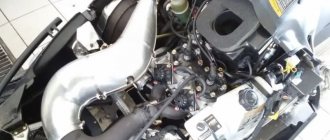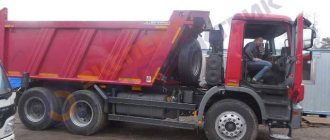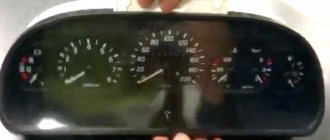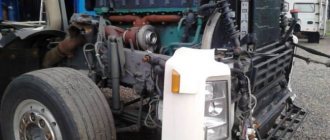Tank calibration
Read more
So, we found out that the main advantage is resistance to corrosion.
If we consider the analogy with a steel tank, then a classic steel tank is strong, wear-resistant, forgives unscrupulous installation, and has a huge reserve of metal fatigue strength (a small digression - metal fatigue is an example - how many times can a metal plate be bent and straightened before it breaks. Steel most resistant to such loads).
Unfortunately, all these undeniable advantages are negated by low corrosion resistance. Imported steel tanks are more or less durable in operation, since they are galvanized and additionally painted both outside and inside. The surface of tanks is galvanized not by galvanic means, but by dipping the tank into molten zinc, which leads, at such high temperatures, to 100% degreasing of the surfaces and the flow of molten zinc into any joint. With this method, the zinc coating layer is as thick as possible, but this galvanizing method is used mainly only in large-scale production. Domestic steel tanks, as a rule, are only painted on the outside, painted very well, with good powder paints, but this does not solve the problem, since without interior painting, the steel tank rots from the inside!
When the car is in motion, the pumping of fuel causes the tank to be washed from the inside. But, in wet or cold weather, as soon as the car sits for several days without moving, the walls of the tank above the fuel level begin to rust intensively. Subsequently, the rust is washed off from the walls and enters the fuel system, clogging it. Moreover, it clogs so badly that parts of the high-pressure fuel system have to be replaced. So, for the information of those operating steel tanks - when the machine is idle for a long time, fill the tanks to capacity!!!
Aluminum tanks are free from the main disadvantage of steel tanks - problems with corrosion. But they also have their weaknesses:
1) Since aluminum is a softer material than steel, it is easier to wipe, which is why it requires the largest possible support surfaces from mounting brackets to tension clamps when installing. If you pay attention to the installed aluminum tanks, they all have very wide brackets and clamps. Narrow and simplified brackets and clamps similar to those placed on steel tanks would simply gradually push through and wear through aluminum!
2) He is very afraid of dents. The metal on the dents begins to “play” as a result of the pumping of fuel and cracks quite quickly. This is due to the fact that aluminum has much lower fatigue strength than steel.
3) It must be necessarily and carefully isolated from the mass of the car body; direct contact of two dissimilar metals such as steel and aluminum must be excluded. The entire body of a machine built using a single-wire electrical circuit is a minus, that is, it is constantly under voltage. Direct contact with a steel bracket or clamp results in so-called galvanic corrosion. Anode-Cathode. This corrosion looks like part of the tank is covered with something like ulcers. Observing these, you can safely conclude that somewhere there is direct contact! The ulcers are not necessarily at the point of contact, they appear where the protective film of aluminum oxide is thinner! To avoid this phenomenon, it is necessary to insulate with reliable thick rubber gaskets between the tank and the bracket, as well as between the tank and the clamp. Such gaskets are not only good insulators, but also create the necessary frictional force to hold the tank and protect against abrasion.
4) The biggest disadvantage of an aluminum tank is its high cost. It is associated with the high cost of the material itself. In price, approximately 70% is the cost of the material!
Despite all the above-mentioned disadvantages, such as high cost and requirements for a more delicate attitude during installation, these tanks are confidently replacing steel tanks, precisely due to their resistance to corrosion and durability, which more than cover all the disadvantages. In modern engines, the fuel system is very sensitive to contamination, and even additional filters cannot protect against rust particles. It is this circumstance that is decisive when installing aluminum tanks at a factory.
They usually purchase a new one either if the factory tank is damaged or a second, additional tank is needed. If the main tank is made of aluminum, you won’t put a steel tank on the other side of the car... Not only will all the traffic police inspectors ask for such a collective farm, but it also openly characterizes the owner of the car, what kind of owner is the car... it’s the same thing come to work in different shoes... Sometimes, if possible, they change the main tank to a similar one with a larger volume.
When ordering a new tank, modifications of your choice are possible. Changing the location of the filler neck and landing fuel intake. Built-in liquid fuel heating system. Mounting places for GLONASS sensors, etc.
The warranty on aluminum fuel tanks is virtually unlimited and is valid UNTIL the tank receives mechanical damage, such as dents, holes, or abrasions. This includes possible mechanical damage to the tank during self-installation. Be careful when installing the tank yourself.
Once again we would like to draw your attention to the cost of the tanks. 70% of the price is the cost of the material. In the Russian Federation there are currently several manufacturers of aluminum tanks engaged in mass production. The material is purchased from the same manufacturers at the same prices, but the price of the final product is different.
The price can be reduced only by reducing the thickness of the material, as well as eliminating some technological processes from production.
This ultimately affects the overall quality of the product. In this regard, before choosing a manufacturer, we strongly recommend that you familiarize yourself with the quality of the products with your own eyes. And only after that draw conclusions about the price-quality relationship. {/spoilers}
Fuel tanks
What are truck fuel tanks? These are complex, high-tech components that ensure maximum reliability of the entire system. They have long ceased to be simple fuel storage facilities. Modern tanks consist of many components and parts and have a capacity of several hundred liters.
Freight transportation is a popular area of activity with great demand among various types of customers. It often happens that delivery involves traveling a huge distance in the shortest possible time. Stopping to refuel is wasted time, not to mention the associated risk in the form of possible theft or damage in the parking lot. A 400 or even 800 liter tank can completely eliminate this need.
For a long time, tanks of increased volume were manufactured independently. But those days are long gone. Truck manufacturers have found a way to increase dimensions. What is the reason? A larger tank carries a larger load. In addition to rigidity and corrosion, many more issues needed to be addressed. Modern analogues are not only larger, but also more reliable. The size of one of the most popular options is 800 liters, and this is far from the limit. Particularly important points include compliance with environmental standards and fire safety of the unit. The harmfulness of fumes decreases every year. Many manufacturers of trucks and tanks in particular focus on this.
Form
The cubic shape is considered the internationally accepted standard today.
Parameters such as length, width and height still remain floating. You can find the following forms: - cube; - cylinder; — D-shaped cube; - oval cylinder. One of the most recent companies to abandon their original tank design was Volvo. The cylindrical shape can be seen on its trucks until 2002.
Design
Any fuel tanks for modern trucks have a number of similar structural elements.
These are: - partitions with holes; — presence of a sump; — fuel sensor; — pressure reduction valve; — a set of filters. Fuel is poured through a special hose built into the neck. At its end there is a filter, most often a regular mesh one. Excess intake fuel is returned by the fuel system to the tank, forming a kind of circulation. The partitions play the role of stiffeners. They also prevent foaming and dampen vibrations during movement. Using a sump, you can drain and flush the system - small particles and water accumulate here. A special valve reduces the pressure when a large amount of vapor is formed. Well, the sensor displays the fill level.
Material
The production of walls and partitions is the specialty of each plant. The most common are iron and aluminum options. Each of them is good in its own way. Iron tanks are more resistant to physical damage. They have great rigidity. However, this is not the most important thing in durability. Corrosion can destroy any metal within the first years after installation. Aluminum models are more environmentally friendly and last longer. The wall thickness ranges from 2 to 3.5 mm. They often have several layers, pressed or welded together.
Calibration of fuel tanks of trucks (1l = 1cm).
As you know, the easiest way to find out how much fuel is in the tank is to measure it with an ordinary stick, which you simply lower into the neck, measure the value... Judging by the fuel indicator on the dashboard, the tank can be empty, half full or full. So this device can only tell whether there is enough fuel until the next gas station, but, as you know, the easiest way to find out how much fuel is in the tank is to measure it with an ordinary ruler, or a stick, which is simply lowered into the neck, measure the value and then, using a calibration table, determine the remaining fuel. In this article we will provide information on different auto manufacturers.
Calibration of fuel tanks of DAF vehicles:
| 400l | 430l | 500l | 560l | 600l | 620l | 690l | 750l | 850l | 870l | 995l | |
| 10cm | 70l | 70l | 70l | 100l | 120l | 100l | 120l | 120l | 140l | 140l | 140l |
| 20cm | 130l | 140l | 140l | 190l | 240l | 200l | 240l | 240l | 270l | 280l | 280l |
| 30cm | 200l | 210l | 210l | 290l | 350l | 300l | 350l | 360l | 410l | 420l | 430l |
| 40cm | 270l | 280l | 280l | 380l | 470l | 400l | 470l | 480l | 540l | 560l | 570l |
| 50cm | 330l | 340l | 350l | 480l | 590l | 500l | 590l | 600l | 680l | 700l | 710l |
| 60cm | 400l | 410l | 420l | 600l | 660l | 720l | 820l | 840l | 850l |
Renault Magnum & Premium fuel tank calibration table:
| Centimeters | Tank 555l. | Tank 410l. | Tank 275l. |
| (liter in cm) | (liter in cm) | (liter in cm) | |
| 1 | 8 | 7 | 4 |
| 2 | 16 | 14 | 8 |
| 3 | 25 | 21 | 12,5 |
| 4 | 33 | 28 | 16,5 |
| 5 | 42 | 35 | 21 |
| 6 | 51 | 42 | 25,5 |
| 7 | 60 | 49 | 30 |
| 8 | 69 | 56 | 34,5 |
| 9 | 78 | 63 | 39 |
| 10 | 88 | 70 | 44 |
| 11 | 97 | 77 | 48,5 |
| 12 | 107 | 84 | 53,5 |
| 13 | 117 | 91 | 58,5 |
| 14 | 127 | 98 | 63,5 |
| 15 | 137 | 105 | 68,5 |
| 16 | 147 | 112 | 73,5 |
| 17 | 157 | 119 | 78,5 |
| 18 | 167 | 126 | 83,5 |
| 19 | 177 | 134 | 88,5 |
| 20 | 187 | 140 | 93,5 |
| 21 | 197 | 147 | 98,5 |
| 22 | 207 | 154 | 103,5 |
| 23 | 217 | 161 | 108,5 |
| 24 | 227 | 168 | 113,5 |
| 25 | 237 | 175 | 118,5 |
| 26 | 247 | 182 | 123,5 |
| 27 | 257 | 189 | 128,5 |
| 28 | 267 | 196 | 133,5 |
| 29 | 277 | 203 | 138,5 |
| 30 | 287 | 210 | 143,5 |
| 31 | 297 | 217 | 148,5 |
| 32 | 307 | 224 | 153,5 |
| 33 | 317 | 231 | 158,5 |
| 34 | 327 | 238 | 163,5 |
| 35 | 337 | 245 | 168,5 |
| 36 | 347 | 252 | 173,5 |
| 37 | 357 | 259 | 175,5 |
| 38 | 367 | 266 | 183,5 |
| 39 | 377 | 273 | 188,5 |
| 40 | 387 | 280 | 193,5 |
| 41 | 397 | 287 | 198,5 |
| 42 | 407 | 294 | 203,5 |
| 43 | 417 | 301 | 208,5 |
| 44 | 427 | 308 | 213,5 |
| 45 | 437 | 315 | 218,5 |
| 46 | 447 | 322 | 223,5 |
| 47 | 457 | 329 | 228,5 |
| 48 | 467 | 336 | 233,5 |
| 49 | 477 | 343 | 236,5 |
| 50 | 485 | 350 | 243,5 |
| 51 | 493 | 357 | 246,5 |
| 52 | 501 | 364 | 250,5 |
| 53 | 509 | 371 | 254,5 |
| 54 | 518 | 378 | 259,5 |
| 55 | 526 | 385 | 263 |
| 56 | 534 | 392 | 267 |
| 57 | 542 | 399 | 271 |
| 58 | 550 | 406 | 275 |
VOLVO D-shaped fuel tanks:
Tank diameter 710
| Tank volume (l) | Tank length(mm) | Measurement height (mm) | |||||||||||||
| 33 | 50 | 100 | 150 | 200 | 250 | 300 | 350 | 400 | 450 | 500 | 550 | 600 | 650 | ||
| 170 | 430 | 4 | 7 | 18 | 30 | 43 | 56 | 70 | 84 | 98 | 111 | 125 | 138 | 150 | 160 |
| 210 | 530 | 5 | 9 | 22 | 37 | 53 | 69 | 86 | 103 | 121 | 138 | 154 | 170 | 185 | 199 |
| 330 | 830 | 8 | 14 | 35 | 58 | 83 | 109 | 136 | 163 | 190 | 217 | 243 | 268 | 292 | 313 |
| 410 | 1030 | 10 | 17 | 43 | 72 | 103 | 136 | 169 | 203 | 237 | 270 | 303 | 334 | 363 | 389 |
| 450 | 1130 | 11 | 19 | 47 | 79 | 113 | 149 | 186 | 223 | 260 | 297 | 332 | 367 | 399 | 428 |
| 480 | 1220 | 12 | 21 | 51 | 86 | 123 | 161 | 201 | 241 | 281 | 320 | 359 | 396 | 431 | 462 |
| 490 | 1230 | 12 | 21 | 52 | 86 | 124 | 162 | 202 | 243 | 283 | 323 | 362 | 399 | 434 | 466 |
| 530 | 1330 | 13 | 22 | 56 | 93 | 134 | 176 | 219 | 263 | 306 | 350 | 392 | 432 | 470 | 504 |
| 570 | 1430 | 14 | 24 | 60 | 100 | 144 | 189 | 235 | 282 | 329 | 376 | 421 | 465 | 506 | 542 |
| 610 | 1530 | 15 | 26 | 64 | 107 | 154 | 202 | 252 | 302 | 353 | 402 | 451 | 497 | 541 | 580 |
| 650 | 1630 | 16 | 28 | 69 | 115 | 164 | 216 | 269 | 322 | 376 | 429 | 481 | 530 | 577 | 618 |
| 690 | 1730 | 17 | 29 | 73 | 122 | 174 | 229 | 285 | 342 | 399 | 455 | 510 | 563 | 612 | 657 |
| 710 | 1800 | 18 | 30 | 76 | 127 | 181 | 238 | 297 | 356 | 415 | 474 | 531 | 586 | 637 | 683 |
| 730 | 1830 | 18 | 31 | 77 | 129 | 184 | 242 | 302 | 362 | 422 | 482 | 540 | 596 | 648 | 695 |
| 730 | 1850 | 19 | 31 | 78 | 130 | 186 | 245 | 305 | 366 | 427 | 487 | 546 | 602 | 655 | 702 |
| 750 | 1900 | 19 | 32 | 80 | 134 | 191 | 252 | 313 | 376 | 439 | 500 | 561 | 619 | 673 | 721 |
| 770 | 1950 | 20 | 33 | 82 | 137 | 197 | 258 | 322 | 386 | 450 | 514 | 576 | 635 | 691 | 741 |
| 810 | 2030 | 21 | 34 | 86 | 143 | 205 | 269 | 335 | 402 | 469 | 535 | 599 | 661 | 719 | 771 |
| 870 | 2196 | 22 | 37 | 93 | 155 | 221 | 291 | 362 | 435 | 507 | 579 | 648 | 715 | 778 | 834 |
Tank diameter 710
| Tank volume (l) | Tank length(mm) | Measurement height (mm) | ||||||||||
| 35 | 50 | 100 | 150 | 200 | 250 | 300 | 350 | 400 | 450 | 500 | ||
| 160 | 530 | 6 | 9 | 23 | 39 | 55 | 72 | 89 | 106 | 122 | 138 | 152 |
| 255 | 830 | 9 | 14 | 36 | 61 | 87 | 113 | 140 | 167 | 193 | 217 | 240 |
| 320 | 1030 | 11 | 18 | 45 | 76 | 108 | 141 | 174 | 207 | 240 | 270 | 299 |
| 380 | 1230 | 13 | 21 | 54 | 91 | 129 | 169 | 208 | 248 | 287 | 323 | 357 |
| 415 | 1330 | 14 | 23 | 59 | 98 | 140 | 182 | 226 | 268 | 310 | 350 | 386 |
| 445 | 1430 | 15 | 25 | 63 | 106 | 150 | 196 | 243 | 289 | 333 | 376 | 416 |
| 505 | 1630 | 17 | 28 | 72 | 121 | 172 | 224 | 277 | 329 | 380 | 429 | 474 |
| 540 | 1730 | 19 | 30 | 77 | 128 | 182 | 238 | 294 | 350 | 404 | 456 | 503 |
| 570 | 1850 | 20 | 32 | 82 | 137 | 195 | 254 | 314 | 374 | 432 | 488 | 538 |
| 600 | 1950 | 21 | 34 | 86 | 144 | 205 | 268 | 331 | 394 | 456 | 514 | 568 |
| 630 | 2030 | 22 | 35 | 90 | 150 | 214 | 279 | 345 | 410 | 474 | 535 | 591 |
Technical support
Naimushin Andrey Alexandrovich +7
Office
+7 (391) 2-811-810 8 This email address is being protected from spambots. You need JavaScript enabled to view it.
